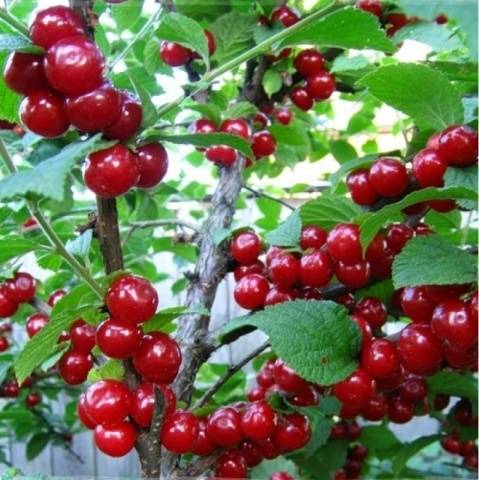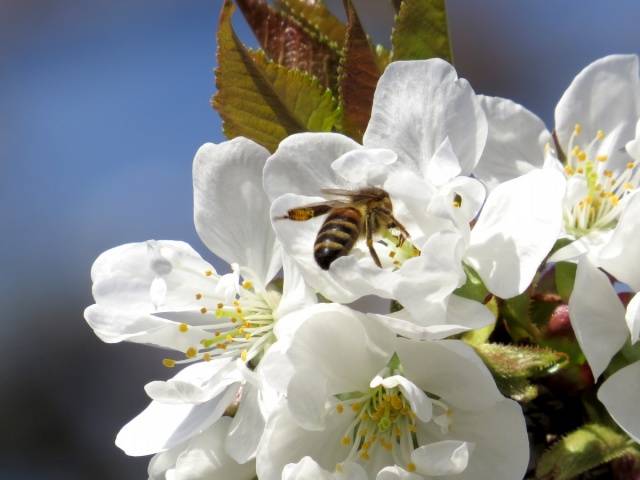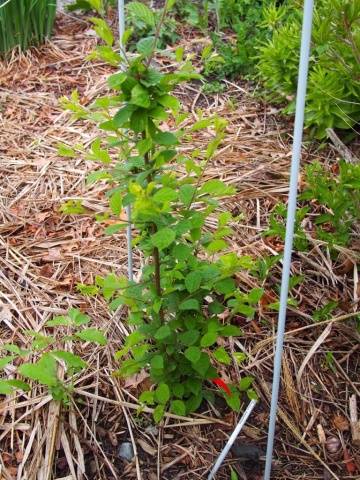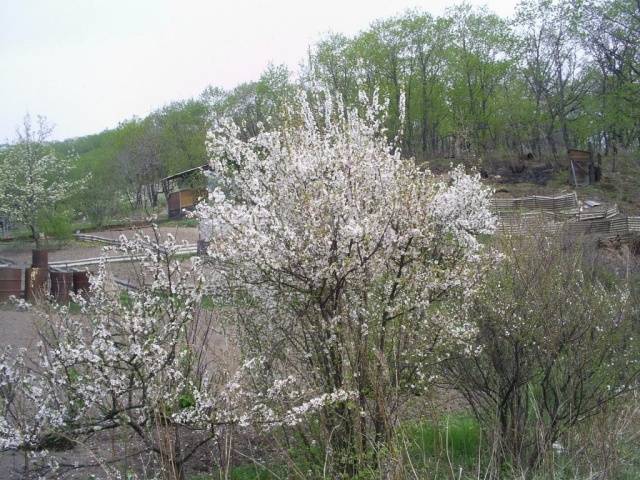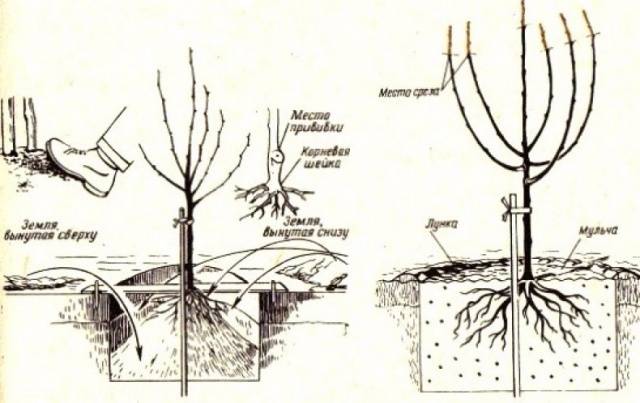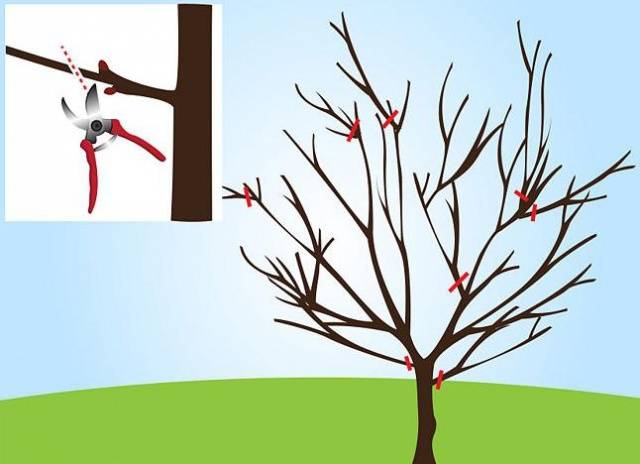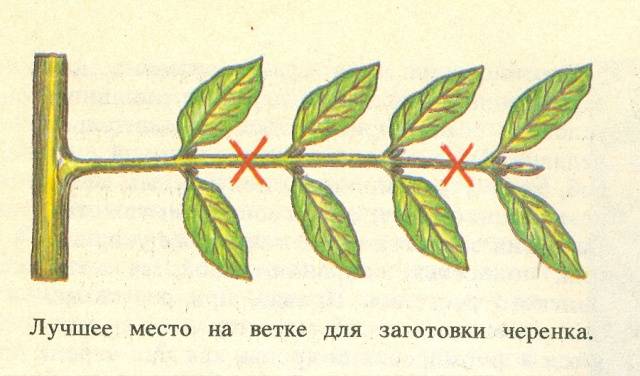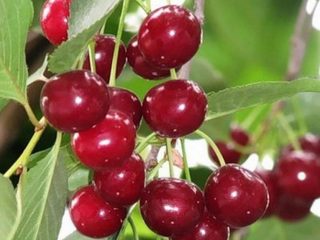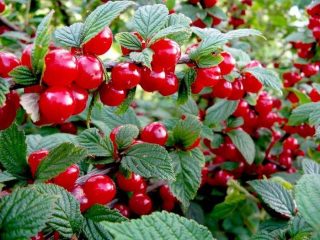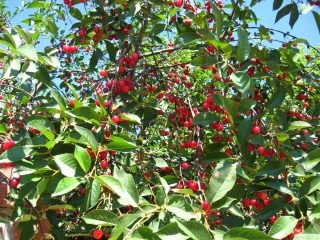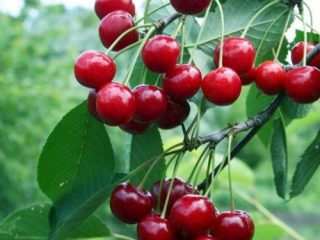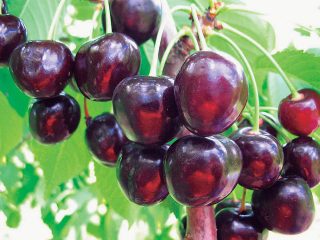Content
Felt cherry Alice is a variety widely known for its versatile characteristics. With correct planting and proper care, the few weaknesses of the Alice cherry will not prevent you from growing a healthy shrub on the site, from year to year, delighting with sweet berries.
Breeding history
Felt cherry variety Alice was brought out by V.P. and N.A.Tsarenko in 1979 at the Far East Experimental Station of VNIIR. It appeared as a result of pollination of the Leto variety with mixed pollen cherry blossoms, Peschanovoylochnaya and Damanka.
The record on the registration of the variety was entered into the State Register in 1997.
Description of culture
The height of Alice's bush, as a rule, does not exceed 1.5 m. It is dense, has an oval shape, and has an average growth rate. The bark of perennial branches is gray, covered with many small light horizontal tubercles - "lentils". The branches of the Alice cherry variety are thick and straight. Young shoots are brown, covered with edging.
Buds are small, pubescent, pointed in shape, slightly deviate from the shoot.
The leaves are dark green, small, in the form of elongated ovals with a pointed tip. The surface of the leaf blade is uneven, folded, with a serrated edge, pubescent on both sides. The petiole is short (0.5 cm), also pubescent, of medium thickness.
The flower is medium (diameter of the corolla is about 2.6 cm), pale pink, in the shape of a saucer, has 5 freely spaced petals.
Alice is a large-fruited variety of felt cherry. The berries weigh 3.3–3.6 g (of which 0.2 g is a seed), in shape they resemble an elongated oval with a slightly sloping top. The skin is maroon, thin, slightly pubescent. The pulp is red, juicy, dense, fibrous. The bone is almost inseparable from it.
The fruiting period of a plant can be up to 17 years.
Initially, the Alisa variety was recommended for breeding in the Far East (in particular, in the Primorsky Territory). However, it later became popular in other regions with milder climates. Good results were shown by the variety when growing the felt cherry Alisa in the Moscow region, the Leningrad region, as well as in the central regions of Russia.
Characteristics
The characteristics of the variety are of great importance when choosing the right cherry variety for growing in different regions and different climatic conditions.
Drought resistance, winter hardiness
Alice belongs to the varieties of cherries that are distinguished by high frost resistance. Shrubs, skeletal branches, and young shoots withstand winter cold well, and flowers - spring frosts.
Pollination, flowering period and ripening times
Alice cherry blossoms in mid-May. In terms of ripening, it is considered mid-season. The berries ripen in mid-July.
Early maturity is another significant characteristic of the Alice felt cherry. A self-rooted seedling gives a harvest for 3-4 years, grafted - earlier, already from the second year after planting in open ground.
The Alice variety is self-fertile.In order for the cherry of this variety to annually please with abundant harvests, it is necessary to plant plants next to it on the site that are suitable for it as pollinators. It can be 4-5 bushes of felt cherries of one or different varieties, the flowering periods of which coincide with Alice's.
Some stone fruit trees belonging to other species can also successfully act as pollinators of the felt cherry variety Alice:
- peach;
- plum;
- almond;
- apricot;
- cherry plum.
Productivity, fruiting
Felt cherry Alice has a high yield. From one bush can be harvested from 6 to 8.5 kg of berries.
The fruits of the Alisa variety are distinguished by a harmonious, pleasant sweet and sour taste. The assessment given to them by the tasters is 4 points out of 5.
Their pulp contains:
- 10.8% dry matter;
- almost 9% sugar;
- 0.68% acids.
Even though the separation of the berries from the stalk is semi-dry, it is difficult to transport them over long distances. Harvesting Alice cherries mechanically is not possible.
Scope of berries
For economic purposes, the fruits of the Alice cherry variety are universal due to their very good taste. They produce juice and all kinds of drinks, prepare marshmallows and marmalade, make preserves, compotes, jams, jam, and also eat fresh.
Disease and pest resistance
Felt cherry varieties Alisa are favorably distinguished by a high degree of resistance to coccomycosis.
Their resistance to clasterosporium is average.
Moniliosis can significantly harm the Alice variety. Waterlogging can cause damage to flowers and berries with this dangerous disease.
Advantages and disadvantages of the variety
Benefits | disadvantages |
Good resistance to high and low temperatures | Self-infertility |
High yield of the variety, coupled with compactness | Weak transportability of berries |
Coccomycosis resistance | Exposure to moniliosis with waterlogging |
Large berries |
|
Early maturity | |
Pleasant taste and universal purpose of the fruit |
Landing features
Compliance with the rules of planting Alice cherries is the key to getting rich harvests. It is very important not only to adhere to the recommendations regarding the timing, but also the place for planting, as well as the composition of the soil.
Recommended timing
You can plant young Alice cherry saplings in the ground both in spring and in autumn. Early spring (usually April) is considered preferable, since the seedlings have enough time to gain strength and grow stronger before the cold weather.
However, an autumn planting (mainly in September) is also quite acceptable. It is important to finish planting work 3-4 weeks before the onset of the first frost.
Choosing the right place
Characteristics of a suitable plot for growing Felted Cherry Alice:
- good sun exposure;
- light soil;
- neutral (not acidic) soil.
Not suitable for this variety:
- heavy, clayey soil;
- a site with a low relief;
- soil saturated with moisture.
What crops can and cannot be planted next to cherries
Good neighbors for Alice will be other felt varieties of cherries, sweet cherries, some stone fruit trees that can become pollinators for her.
Elderberry will get along well with cherries, protecting them from aphids.
Grapes grow remarkably in the neighborhood not only with cherries, but also with many other trees.
Begonias, phloxes, roses and other moisture-loving flowers cannot grow next to Alice's felt cherry, since waterlogging of the soil will create serious problems for her.
Gooseberry and raspberry roots take nutrients from the upper soil layers, thereby inhibiting the development of Alice cherries.
Solanaceous crops (pepper, tomato, tobacco) can become a source of diseases dangerous for cherries.
Walnut leaves secrete substances that inhibit the growth of many other plants, including the Alice cherry.
Conifers strongly acidify the soil, so for felt cherries, which prefers soil with neutral acidity, they are bad neighbors.
Selection and preparation of planting material
Cherry seedlings of the Alice variety should be purchased from trusted sellers, since buying from hands can turn out to be a failure and not bring the desired result.
The planting material should look like this:
- a healthy-looking, undamaged root system, the length of which should be at least 20-25 cm;
- powerful, well-developed shoots;
- the presence of well-developed kidneys.
Before planting, the roots of the seedlings should be slightly trimmed, and then dipped in clay with wood ash mixed with water (you can add a root growth stimulant to this mixture).
Landing algorithm
When planting a felt cherry Alice on the site, you must:
- make sure that the distance between the seedlings is at least 1.5 m, and the depth and width of the planting pit for each of them is about half a meter;
- at the bottom of the pit there should be soil mixed with organic fertilizers;
- the seedling is lowered vertically into the hole, making sure that the root collar is not too deep;
- after planting, the soil in the trunk circle is carefully compacted, well watered and mulched with peat.
Follow-up care of the culture
Caring for Alice felt cherries after planting involves pruning, watering, feeding the plant, protecting it from rodents and preparing for winter.
Cut cherry bushes of the Alice variety in autumn or spring. This is done:
- to form a crown;
- in order to rejuvenate;
- with a strong growth of branches.
More details on how to properly prune cherries can be found in the video
Water the felt cherries in moderate portions, being careful not to accumulate moisture in excess. The plant needs watering, first of all, during the dry period, as well as in the phase of budding and fruit formation.
Top dressing is applied neatly, along the edge of the trunk circle, at a time when the cherry has already faded. For 1 sq.
- organics - 5-7 kg;
- phosphorus-containing - 70 g;
- nitrogen - 30 g;
- potash - 20 g.
Nitrogen-containing substances and organic matter should be applied in the spring, and phosphorus and potassium in the fall.
In order to prevent mice and other rodents from gnawing the bark of felt cherries in winter, gardeners are advised to tie the trunks with artificial covering material, reeds, spruce branches, raspberry shoots, after moving the ground a little from the trunk.
In winter, at the base of the trunks, the snow should be trampled down tightly - then the mice will not be able to move on it. However, it will be necessary to remove it from the bushes in the spring.
Diseases and pests, methods of control and prevention
Despite the variety of varieties, there is hardly a crop that will have exceptional immunity to diseases and pests. Each variety has its own weak points. Briefly about the pests and diseases that can threaten the Alice cherry, you can find out from the table.
Disease / Pest | Manifestations and damage done | Prevention and control |
Clasterosporium disease | Small spots - "holes" on the leaves. The pathogen is able to penetrate into the branches. "Ulcers" on affected fruits | 1. Cutting off and burning the affected parts of the plant. 2. Spraying with Bordeaux liquid (3%), biological products |
Moniliosis | Withering of flowers, leaves, drying of shoots | 1. Prevention - fungicide treatment. 2.Fighting - destruction of the affected parts of the bush, spraying with preparations containing copper |
Pocket mite | "Warts" on the leaves in the middle of summer - the insect sucks the juice out of them | Watering from a watering can with hot water before the buds open and after the leaves fall |
Felt cherry propagation methods
Reproduction of the felt cherry Alice, while retaining the valuable qualities inherent in the variety, succeeds well with green cuttings. To do this, take twenty-centimeter (or more) cuttings with at least 4 internodes. Before planting, their tips are placed in a solution that stimulates growth for 10-12 hours. Then the cuttings are planted in the ground, where they take root for a month.
In addition to this method, the Alice cherry variety can be propagated:
- lignified cuttings:
- layering from the roots;
- by vaccination method;
Conclusion
The felted cherry of the Alice variety has long gained popularity among gardeners, which is due to its many inherent benefits. Large and tasty berries, high yield, resistance to drought and frost in an advantageous way distinguish this variety from many others. Among the few shortcomings are self-infertility and sensitivity to an excess of moisture, however, the advantages of the variety more than compensate for them.
